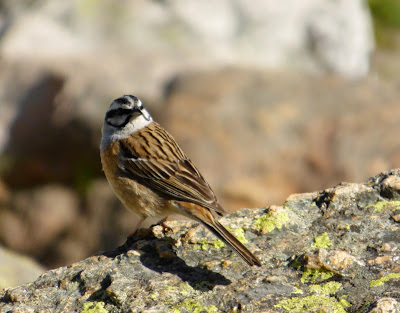Además de los machos de cabra montés de la entrada anterior, fueron varias sorpresas y animales varios las que nos encontramos el otro día recorriendo parte del P.N de Peñalara.
Besides the male ibex in the previous post, we had some surprises and several animals that we found the other day walking around in the PN Peñalara.
En la zona del parking y el centro de interpretación, así como el principio del sendero que transcurre por pinar de pino albar y pino negro se empezaron a ver y escuchar las primeras aves; corneja negra (Corvus corone), verderón serrano (Carduelis citrinella), piquituerto común (Loxia curvirostra), carbonero garrapinos (Periparus ater), herrerillo capuchino (Lophopanes cristatus), papamoscas cerrojillo (Ficedula hipoleuca), pinzón vulgar (Fringilla coelebs), cuervo (Corvus corax), jilguero europeo (Carduelis carduelis), reyezuelo sencillo (Regulus regulus).
In the parking area and the interpretive center and in the beginning of the path that runs through pine forest; scots pine and black pine, we began to see and hear the first birds; crow (Corvus corone), Citril (Carduelis citrinella), common crossbill (Loxia curvirostra), coal tit (Periparus ater), crested tit (Lophopanes cristatus), pied flycatcher (Ficedula hipoleuca), chaffinch (Fringilla coelebs), raven (Corvus corax), european goldfinch (Carduelis carduelis), goldcrest (Regulus regulus).
Y también algunas rapaces; buitre negro (Aegypius monachus), buitre leonado (Gyps fulvus), Águila calzada (Aquila pennata) y Águila culebrera (Circaetus gallicus).
And some raptors; black vulture (Aegypius monachus) griffon vulture (Gyps fulvus), Booted eagle (Aquila pennata) and short-toed eagle (Circaetus gallicus).
Pastizal y brezal de alta montaña
Ya en los pastos subalpinos se observaron otras especies como; colirrojo tizón (Phoenicurus ochruros), avión roquero (Ptyonoprogne rupestris), collalba gris (Oenanthe oenanthe), pardillo vulgar (Carduelis cannabina), escribano montesina (Emberiza cia), acentor común (Prunella modularis).
And in subalpine grasses we observed other species such; black redstart (Phoenicurus ochruros), crag martin (Ptyonoprogne rupestris), northern wheatear (Oenanthe oenanthe), linnet (Carduelis cannabina), rock bunting (Emberiza cia), hegde accentor (Prunella modularis).
Collalba gris (Oenanthe oenanthe) Northern weathear
Collalba gris (Oenanthe oenanthe) Northern weathear
Escribano montesino (Emberiza cia) Rock bunting
Escribano montesino (Emberiza cia) Rock bunting
Escribano montesino (Emberiza cia) Rock bunting
Escribano montesino (Emberiza cia) Rock bunting
Acentor común (Prunella modularis) Hedge accentor
Collalba gris (Oenanthe oenanthe) Northern weathear
Dentro del grupo de los reptiles pudimos observar varias especies de lacértidos:
Within the group of reptiles we saw some species of lacertids:
Lagartija roquera (hembra) (Podarcis muralis) Wall lizard (female)
Lagartija roquera (macho) (Podarcis muralis) Wall lizard (male)
Lagartija roquera (macho) (Podarcis muralis) Wall lizard (male)
Lagarto verdinegro (macho) (Lacerta schreiberi) Iberian emerald lizard (male)
Lagarto verdinegro (macho) (Lacerta schreiberi) Iberian emerald lizard (male)
Lagarto verdinegro (macho) (Lacerta schreiberi) Iberian emerald lizard (male)
Lagartija carpetana (hembra) (Iberolacerti cyreni) Carpetane rock lizard (female)
Lagartija carpetana (macho) (Iberolacerti cyreni) Carpetane rock lizard (male)
Lagartija carpetana (macho) (Iberolacerti cyreni) Carpetane rock lizard (male)




















1 comentario:
What beautiful photos! I always wonder what the names of the animals are when I'm in the Sierra!
Publicar un comentario